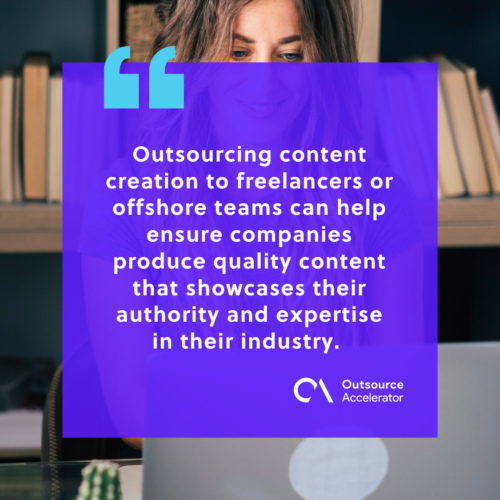Derek Gallimore is a contributor to Forbes.com and a member of the Forbes Business Council. This article was first published on Forbes.
Content remains king, especially in our digitalized world. Every business on the internet uses content to establish its presence and get ranked on search engine pages.
However, planning and creating content from scratch is not always easy, even for expert marketers. In-house teams in startups are often so riddled with work on their websites and social media accounts that much of their content is left undone. Fortunately, technology these days gives these teams options to lighten their workload. They can outsource content creation to service providers or have an AI assist with this task.
While both methods are welcomed by teams worldwide, fears and speculations still arise regarding what extent one can use them. Let’s look at AI and outsourced content and examine which is an ideal service to use at what time.
Using AI-generated content in 2023
Despite being around for years, the use of AI for content creation has been booming, with OpenAI leading the way. More marketers have recently been using AI content in different forms. Aside from campaigns and processes, it is now used to generate several forms of media, from blog posts to images and music.
The use of AI for content creation is plagued with praise and doubts. While a growing number of users will argue its advantages in making content creation more efficient, some fear that the system could spike plagiarism and authenticity issues.

Pros of AI content on brands
AI content can be both valuable and disadvantageous to a business, depending on how you use it. Here are some of the pros.
• Increased efficiency in content creation: AI creates content much faster. It only takes a few minutes to generate a 1,000-word article through short commands. With this, content creation becomes quicker and more efficient.
• Cost-effectiveness: Many content generation tools in the market are free, while some will have a small subscription rate. Having AI content can be cost-effective compared to hiring professional human writers, especially for new businesses.
• Great idea-starter: Content writers sometimes don’t have a single idea for starting an article on a topic they’re not familiar with. AI can help them generate outlines and prompts to get them started.
Cons of using AI for content creation
• Issues with quality and authenticity: AI is unreliable for generating sources and statistics for expert content. Due to this, teams still need the help of human staff to carefully check and verify the authenticity of every AI-generated content.
• Potential plagiarism strike: Each content generated by AI is literally spliced from thousands of other content on the web—possibly even word for word. This could result in plagiarism strikes and other related violations.
• Possible website devaluation: Google recently updated its guidelines with the “helpful content update,” which strikes websites with AI-generated content. This could devalue websites that are found violating the search engine’s content guidelines.
Outsourcing content creation and management
Outsourcing content creation and management is a great way for businesses to save time and money while still producing high-quality content. This is still ideal for business owners looking to hire more staff for their content marketing efforts. Reports from past years found that 84% of B2B marketers outsource their content services. Meanwhile, 55% of B2C marketers do the same.
Benefits of outsourcing content management
• Producing quality content: Outsourcing content creation to freelancers or offshore teams can help ensure companies produce quality content that showcases their authority and expertise in their industry. Outsourced teams can write content backed by research and the latest data from reliable institutions.
• Fresh perspectives: Human-created content can also provide fresh perspectives on the topics and types of content your business shares. Companies can even repurpose or create new forms of content out of their existing ones, from infographics to video and audio formats.
• Flexibility: Organizations can hire writers and other related roles depending on their needs and the volume of content they will create. Compared to in-house staffing, offshore writers and creators can be hired for project-based and short-term roles.

How to improve your outsourced content
Even with human-generated content, marketing teams can still experience faults and mistakes in creating content for their company. Their content might still be subject to copyright strikes, lack of SEO optimization and misalignment with the brand’s image. To prevent this, organizations can use the following tips to improve their outsourced content.
• Create a style guide. Establish a style guide that indicates proper formatting and use of a brand’s voice in creating content.
• Hire an editor. Have a competent editor check and modify each piece of content before publishing them to websites and social media pages.
• Curate the topics. Check the topics each writer will use. Or, better yet, provide a list of topics they can choose for creating articles and other forms of content.
Choosing between AI or outsourcing
Regardless of what service you will use, remember that both AI and outsourced content can make or break your content marketing strategy. You can use AI-generated content as a foundation for your content strategy and take advantage of its speed and accuracy to create a few articles and other forms of media you prefer to use.
However, always check and modify everything generated by your AI platform. Inaccuracies and Google’s new policy could cost you your credibility and ranking.
Outsourcing content, meanwhile, is a great strategy for the scalability and effectiveness of your efforts. You can tap them to create expert, research-backed and optimized content. However, be mindful of the experience of those you work with when hiring freelancers or teams that could affect the quality of the content you produce.

 Independent
Independent





















